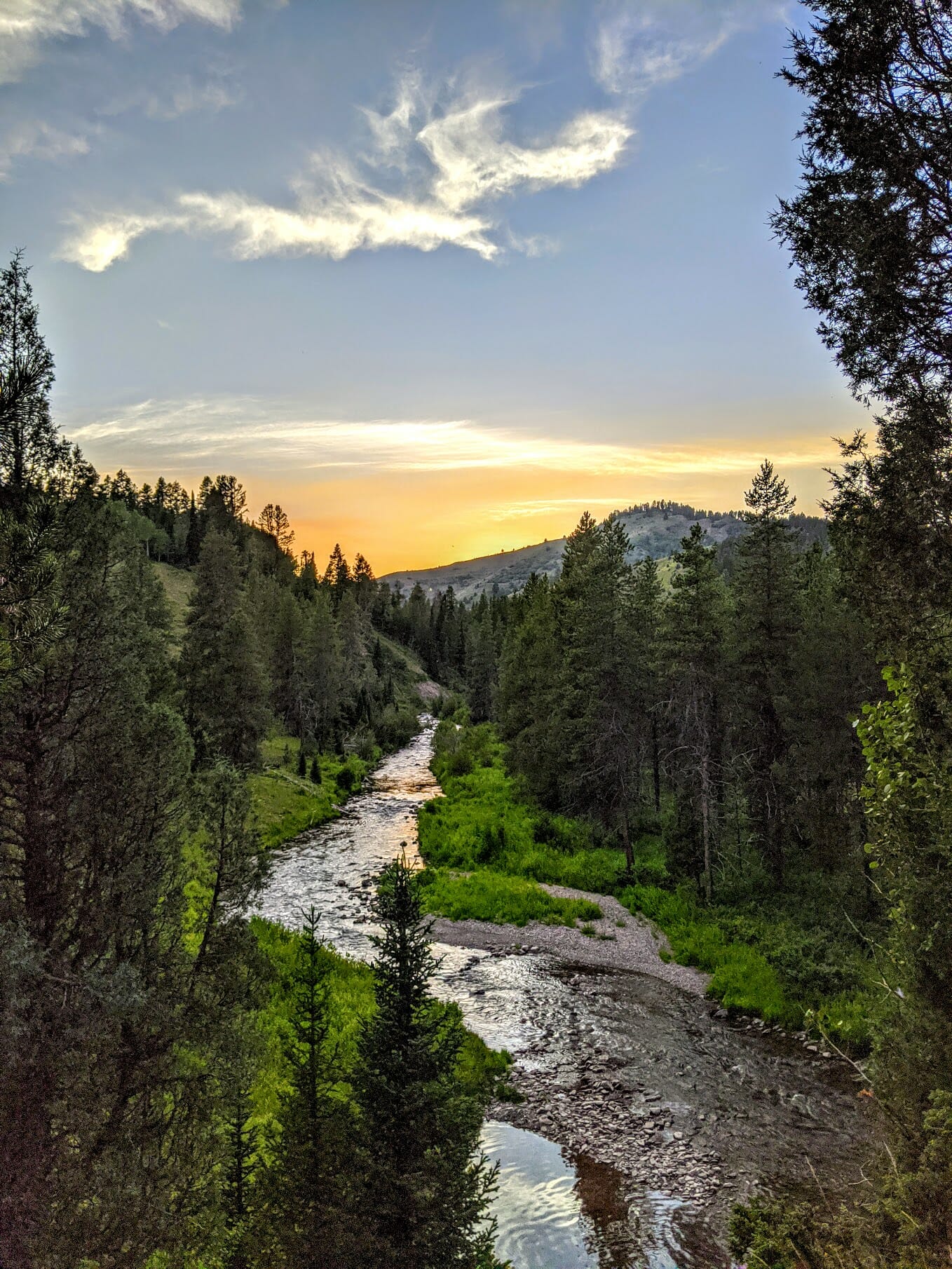The Caribou National Forest, Idaho. Chris Hunt photo.
Editor’s note: In celebration of Public Lands Month, several TU anglers are showcasing their favorite public lands fishing and hunting destinations. America’s public lands are our national treasure — places that have storied histories for all people, from Indigenous Americans to modern-day hunters and anglers. Keeping them intact, healthy and functional is good for the country and good for its people.
The Caribou National Forest
I met a great group of folks about a week ago while I was camping with friends at one of my favorite spots on the Caribou National Forest of eastern Idaho.
Archery elk season had started, and the large dispersed camping area we usually choose for our spot was busier than usual (although, the last couple of summers have been busier than usual in the woods — good, bad or otherwise). When our group arrived to set up camp for a long weekend, a large fifth-wheel trailer and a couple of tents were occupying a prime spot, but they clearly left room for more visitors.
Etiquette in mind, rather than just set up shop next to an active camp, we walked over and asked the folks at the existing camp if they were OK with us kind of horning in — we weren’t really, because it’s a big spot, but we also didn’t want to ruin the experience for anyone else. The group consisted of a bunch of avid hunters from Tennessee, and when we spoke to them, they were more than happy to have us take the spot about 200 yards down the hill from them. We struck up a conversation, invited them over to have a cocktail later and spent the next three days or so checking in on their hunting success — the second day, one of the younger hunters bagged a 6 x 7 bull over the ridge from the site.
The experience served to restore some of the faith I’d lost over the last year, as a couple of experiences I had with new public lands users didn’t go as they should have. As the pandemic continues to rage across the country (and it’s no different here in Idaho, where our hospitals are now forced to make life-or-death decisions at the admissions desks), more folks are heading to the hills to recreate. This particular spot is pretty close to home, and I’ve been camping and fishing there for the better part of two decades. Never have I seen it so busy, and, unfortunately, never have I seen more ignorant misbehavior from people frequenting the Caribou.
“You’re so lucky,” said one of the young hunters as he spread his arms out wide and gazed out over the expanse of national forest land, sliced perfectly down the middle by maybe my favorite trout stream on the planet. “You live here. We don’t have this in east Tennessee.”
Importantly, this particular piece of U.S. Forest Service land is also the ancestral home of the Shoshone and Bannock tribes — the first humans to use the land. We now visit this area, largely for recreation, and, to a smaller extent, for subsistence. Before European-Americans made their way here, this land was vital to the lives of Indigenous Americans.
And yes, I’m lucky, indeed. And, I’ll admit, sometimes I take the abundance of public lands near my home in Idaho Falls for granted. But after a nice visit with my fellow public land owners from Tennessee recently, I’m remembering to check myself. Not everybody in the country enjoys such a bounty. If you live close to public lands like I do, I hope you never forget to appreciate them.
— Chris Hunt
The Sierra National Forest
The vast majority of the best experiences I’ve had in the outdoors have one thing in common: public lands made them possible.
I’m partial to public lands locales that offer a bit of altitude, dispersed camping, scenic views, few other people, good hiking and climbing, and cold, clean water — preferably with trout in it. I like places where you can hear elk bugling in the fall and mountain quail whirring in the brush in the spring. I’ve found sweet spots that meet most if not all of these criteria in Wyoming’s Wind River and Bighorn mountains, throughout Colorado, in northern Arizona, and especially in California’s Sierra Nevada range.
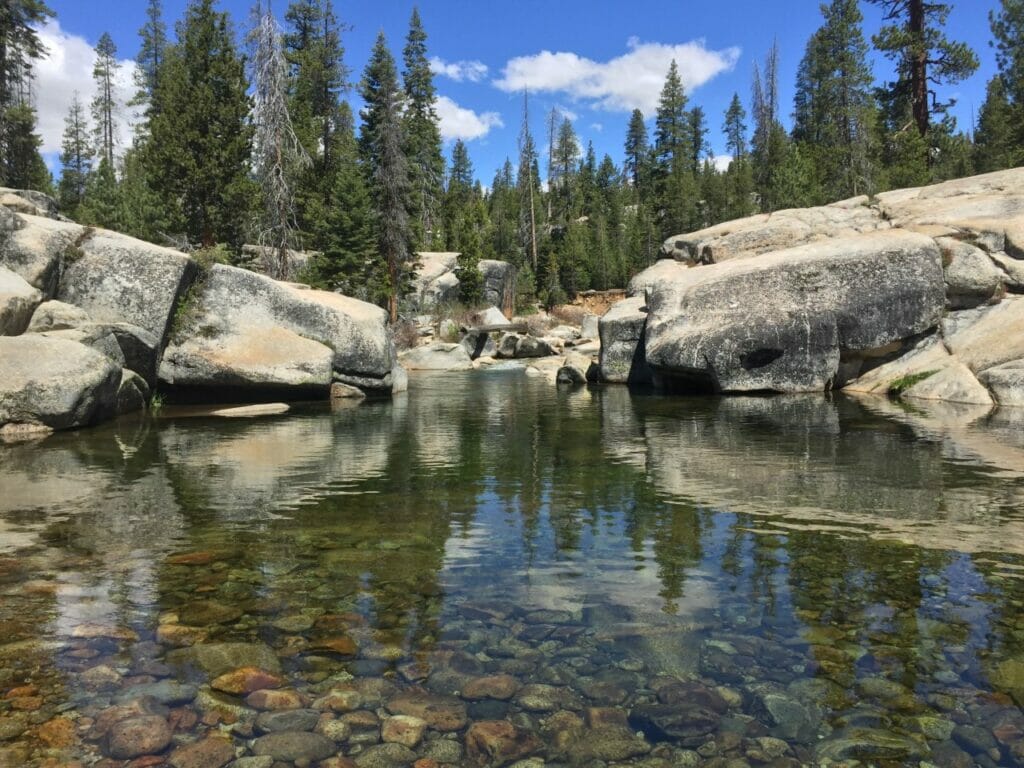
One of my go-to places on public lands is in the upper San Joaquin River watershed in the Sierra National Forest, between Yosemite and Kings Canyon National Parks. There’s a Forest Service campground, infrequently used and with a single outhouse and decrepit picnic tables, at the end of a long road that will give you a chiropractic adjustment which finally bears you to a creek where, at low water, you can cross in a high clearance vehicle and access dispersed camping and good deer hunting opportunities.
On the near side of this creek is the campground, with perhaps 10 sites total; an outfitter sometimes sets up shop there in the summer and fall with his pack stock. The creek runs clean and clear and has small but lovely wild trout and, in some years, a few stockers. My brother and I and other friends have spent many happy days in this area, drunk on the beauty of the blue-sky backdrop to the dense green of pine and fir and cedar, the trickle of water over stone, the siren call of an afternoon breeze in the conifers. Every now and then, if you’re paying attention, you might find signs of the people — the Miwok — who called this region home before white settlement of the West.
Did I mention that you may very well have this place all to yourself, or maybe you’ll find one or two other parties there? No reservation or special permit needed. Go when you feel like it.
Like many of the best destinations, it requires some effort to get to this place. But I feel grateful to have this kind of resource less than a day’s drive from my home, as well as for this country’s unique public lands legacy, which has kept such places largely undeveloped, good for fishing and hunting, and readily accessible for all Americans.
— Sam Davidson
San Juan National Forest
Where I live, public lands are abundant. With over 22 million acres of public lands in Colorado, I have nearly endless places to recreate. Sometimes I have a hard time deciding where to go and what to do thanks to the overwhelming number of options.
Fishing, biking, hiking, camping, skiing, yoga-ing: these are all things I love to do on my/our public lands. With the colors changing on the populus tremuloides, or quaking aspens, fall is my favorite time to explore these lands.
To celebrate anniversary No. 16, we recently hiked Hesperus Mountain (Dibé Ntsaa in Navajo) in southwest Colorado. The only “13er” in the La Plata Range, we shimmied up the talus fields through changing foliage until rocks covered the trail. The steep ascent keeps the numbers at bay, but the sights from the top are worth the effort.
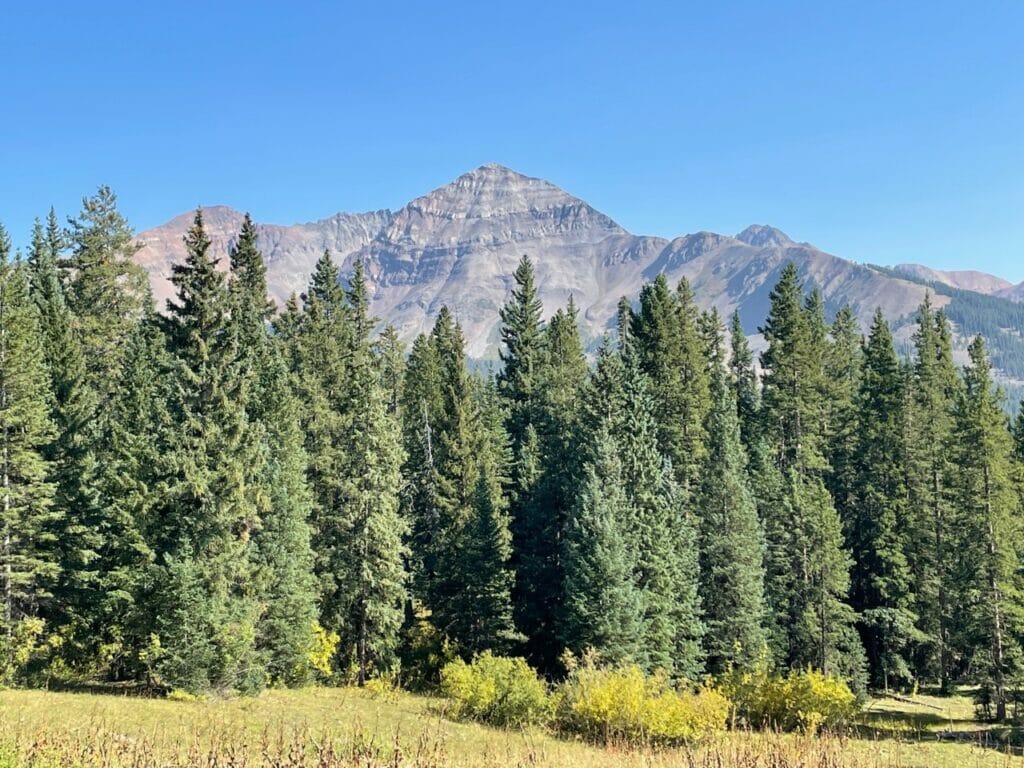
Hanging at the peak, I contemplated the many people who have summited this mountain and committed to learning more about the history of this mountain and area. Dibé Ntsaa is also known as the Navajo People’s Sacred Mountain of the North. It marks the northern boundary of their traditional lands. Before Navajo, it was their Puebloan ancestors who looked to this peak to see smoke signals visible from Chaco Canyon to the south as well as important landscapes to the west and east. The San Juan Mountains, in which Hesperus Mountain sits, is also the traditional homeland of the Ute People. With so much history, I have much to learn.
After taking some time to draw and write some words in my journal, our lungs and legs recovered enough to head down the pea-size gravel that allowed us to “ski” down and drop elevation quickly. The columbine plants were flowerless, but their fall colors shone brightly in the fading summer light. Learning about the flora and fauna helps me connect to the land, but I know I have more learning to do.
This Public Lands Day (Saturday), I will reflect on the long history of our public lands and commit to creating a more hopeful future in working with tribes to better ensure our land management practices are inclusive of all stakeholders. How will you celebrate our long public lands history?
— Kara Armano
The George Washington National Forest
Out here in the East, we really don’t have the expansive acreage of public lands that exist in the West. We do have some great national forest lands, but the amount is pretty diminutive compared to the, say, 16 million acres in Oregon.
In Virginia, the George Washington and Jefferson national forests cover only a meager 1.6 million acres.
Wait a minute! A “meager” 1.6 million acres?
Sure, that may be a tenth of what Oregon boasts, but it’s still a lot of ground open to fishing, hunting, hiking, camping, birding, biking, trail running and pretty much any other wholesome form of outdoor recreation you set your mind to.
It’s pretty close for those of us who live in the western half of the state, with various tracts —some huge, some smallish — stretching pretty much along the spine of the Blue Ridge and Allegheny mountains from the state’s deep southwest all the way to the northern tip not too awfully far from Washington, D.C.
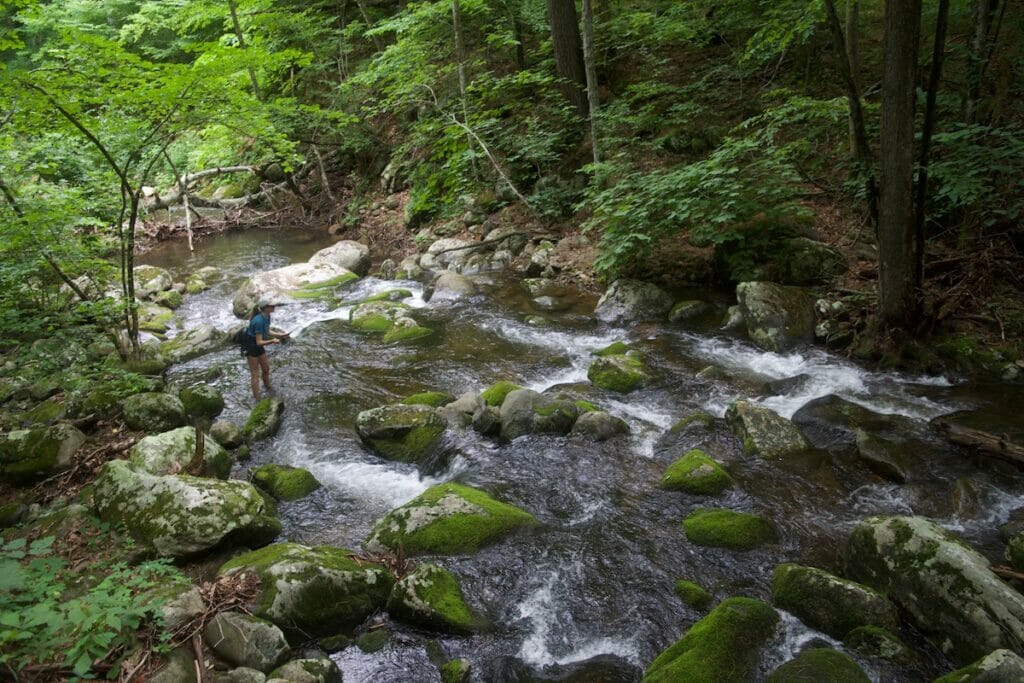
From my house in the heart of Roanoke, I can be hiking the Appalachian Trail through “the George” in about 20 minutes. One of my favorite wild brook trout streams is a reasonable 45 minutes away. The same creek also happens to run through one of my favorite turkey-hunting valleys.
This may seem counterintuitive, but despite the convenience these lands aren’t overly crowded. I can think of no more than a couple of times in the past 20 years when I’ve shown up at a chosen blue line to find someone already there. With more than 90 percent of Virginia deer hunters doing their thing on private agricultural lands, that leaves a lot of acreage available to those of us who like the challenge of hunting the big woods.
As Virginia’s population density continues to shift from rural communities to larger towns and cities (like just what is happening about everywhere else), I realize there will likely be more folks looking to get away in my favorite national forest. That’s just fine. I’m comfortable knowing there’s still plenty of room for all of us.
— Mark Taylor
Routt National Forest
There’s a peak above the river. Like the steep talus cliffs entering the canyon it’s distinguishable. As soon as you round the bend on the gravel road, it appears along with the river in all its majesty.
For many years it feels as if I chose, purposely, to ignore it. Often, I’d glance up but never wondered what was beyond the ridgeline. I simply kept my eyes on the river bottom and its red canyon walls lined with generations of eagle’s nests, old, departed relics of the mining era and ponderosa pines clinging to life high above.
It wasn’t until a friend of mine asked me to join him on a third-season elk hunt that I discovered that peak above the river. I’ll never forget the moment we crossed the bridge and headed up further and further toward the peak. The terrain was teeming with life as mule deer bounced through sage filled meadows, dusky grouse busted from their cover and moose lazily grazed with their calves in the willow choked stream bed.
How could I have ignored this for so long? So much of my time has been spent on the river bottom that I’ve failed to look beyond the high-water line.
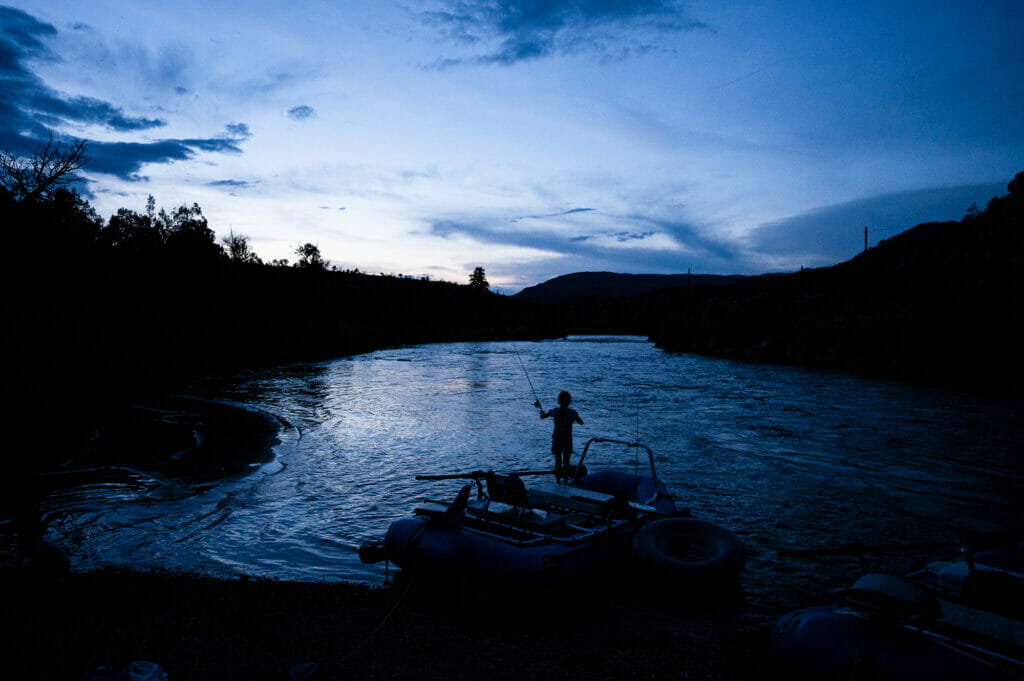
When I first began hunting, in my early 30s, I bounced around from unit to unit. I was excessively transient and had no clue what I was doing. Like many, I’d spend hours scouring maps and looking at Google Earth for the most likely spot an elk would be spotted. I was an angler, not a hunter. I marveled at getting to know, for a brief time, vast chunks of national forest and BLM lands but I never really knew those lands well enough to understand the rhythm of the ecosystem.
One would have to spend generations in a place to truly understand the complexity of our public lands.
As I’ve aged and discovered the value in getting to know a specific place, almost down to a drainage-by-drainage scale, I still can’t help to think about what it must have been like when the Ute tribe first inhabited this pristine land. What did they see? How did they adapt? What was the river like back then?
The questions could go on for days. I long for answers to those questions, but sometimes it’s better off leaving it all up to imagination.
Being the first generation of our family to hunt, fish and walk this piece of land comes with the responsibility of passing down not only the knowledge gained from many years spent hunting and fishing, but also the healthy respect for those who came generations before us.
That’s what public lands mean to me and that’s exactly how I will pass them on to my children.
— Josh Duplechian



